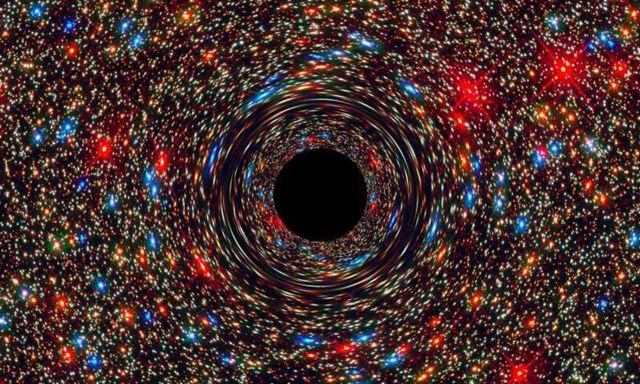
Read more at: https://phys.org/news/2017-06-explanation-intermediate-sized-black-holes.html#jCp
This computer-simulated image shows a supermassive black hole at the core of a galaxy. The black region in the center represents the black holes event horizon, where no light can escape the massive objects gravitational grip. The black hole’s powerful gravity distorts space around it like a funhouse mirror. Light from background stars is stretched and smeared as the stars skim by the black hole. Credit: NASA, ESA, and D. Coe, J. Anderson, and R. van der Marel (STScI)
A pair of researchers, one with the Weizmann Institute of Science in Israel the other with Princeton University in the U.S. has come up with a possible explanation for the inability of space scientists to find any intermediate-sized black holes. In their paper published in the journal Nature Astronomy, Tal Alexander and Ben Bar-Or offer an outline of current theories regarding how black holes in general are believed to develop, theories about the early universe, and finally, their ideas on how current theories may lead to an explanation for the dearth of intermediate sized black holes.
Despite their popularity both in real science and science fiction, the concept of a black hole has only been around for a hundred years, as predicted by Albert Einstein. The term itself did not come into use until 1967, and it was just 46 years ago that the first one was identified. Physicists have learned much about black holes, though, particularly over the past several decades, but one glaring mystery remains—why have scientists never been able to spot one in the intermediate size range? Many large and small ones have been found, but none in the middle. In their paper, Alexander and Bar-Or suggest that our inability to find mid-sized black holes does not mean they do not exist—we just might have to look for them in other places.
The researchers suggest that there may be fewer, or even no intermediate black holes today because of the way they grow—prior research has indicated that they likely get bigger as they “eat” stars. If so, they contend, then their calculations show black holes growing at a rate of one solar mass per 10,000 years. That means, they note, that if a black hole was born soon after the universe came into existence approximately 13.8 billion years ago (which is believed to be the case for large black holes), a black hole would have grown well past the intermediate stage by now. They also suggest that if intermediate-sized black holes do exist, they might reside in dense parts of the sky, which would make them very hard to spot. But such problems might be overcome soon, they note, as new technology has begun detecting gravitational waves.
More information: Tal Alexander et al. A universal minimal mass scale for present-day central black holes, Nature Astronomy (2017). DOI: 10.1038/s41550-017-0147
